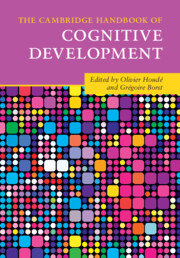Book contents
- The Cambridge Handbook of Cognitive Development
- The Cambridge Handbook of Cognitive Development
- Copyright page
- Contents
- Figures
- Tables
- Contributors
- Introduction
- Part I Neurobiological Constraints and Laws of Cognitive Development
- Part II Fundamentals of Cognitive Development from Infancy to Adolescence and Young Adulthood
- Introduction
- Subpart II.1 Infancy: The Roots of Human Thinking
- 7 Differences between Humans, Great Apes and Monkeys in Cognition, Communication, Language and Morality
- 8 Infants’ Physical Reasoning and the Cognitive Architecture that Supports It
- 9 Infant Categorization
- 10 Foundational Considerations
- 11 How Sophisticated Is Infants’ Theory of Mind?
- 12 Social Cognition and Moral Evaluation in Early Human Childhood
- 13 Scientific Thinking and Reasoning in Infants and Young Children
- 14 Computational Approaches to Cognitive Development
- Subpart II.2 Childhood and Adolescence: The Development of Human Thinking
- Part III Education and School-Learning Domains
- Index
- Plate Section (PDF Only)
- References
9 - Infant Categorization
from Subpart II.1 - Infancy: The Roots of Human Thinking
Published online by Cambridge University Press: 24 February 2022
- The Cambridge Handbook of Cognitive Development
- The Cambridge Handbook of Cognitive Development
- Copyright page
- Contents
- Figures
- Tables
- Contributors
- Introduction
- Part I Neurobiological Constraints and Laws of Cognitive Development
- Part II Fundamentals of Cognitive Development from Infancy to Adolescence and Young Adulthood
- Introduction
- Subpart II.1 Infancy: The Roots of Human Thinking
- 7 Differences between Humans, Great Apes and Monkeys in Cognition, Communication, Language and Morality
- 8 Infants’ Physical Reasoning and the Cognitive Architecture that Supports It
- 9 Infant Categorization
- 10 Foundational Considerations
- 11 How Sophisticated Is Infants’ Theory of Mind?
- 12 Social Cognition and Moral Evaluation in Early Human Childhood
- 13 Scientific Thinking and Reasoning in Infants and Young Children
- 14 Computational Approaches to Cognitive Development
- Subpart II.2 Childhood and Adolescence: The Development of Human Thinking
- Part III Education and School-Learning Domains
- Index
- Plate Section (PDF Only)
- References
Summary
William James once famously wrote in his Principles of Psychology (1890 [2013]) that the infant “assailed by eyes, ears, nose, skin, and entrails at once, feels it all as one great blooming, buzzing confusion.” According to James, infants are overwhelmed by the bombardment of information available to the senses, and consequently their ability to perceive and learn is limited in the first months of life. This perspective remained dominant in the early days of developmental psychology – perhaps reified by Piaget’s (1952) claim that infants’ rely on their senses and motor skills until two years of age – but the last forty years of research on this issue has revealed a startlingly different picture of infants’ perceptual and cognitive abilities. For example, experimental work has demonstrated purportedly that infants in the first year of life can compute simple addition and subtraction (Wynn, 1992), have a basic grasp of certain physical principles (Baillargeon, 1987), perceive launching events as causal (Oakes & Cohen, 1990), have expectations about how animates – people and animals – engage in motion (Spelke et al., 1995), and interact with other animates (Hamlin et al., 2007), among other things.
- Type
- Chapter
- Information
- The Cambridge Handbook of Cognitive Development , pp. 195 - 215Publisher: Cambridge University PressPrint publication year: 2022



